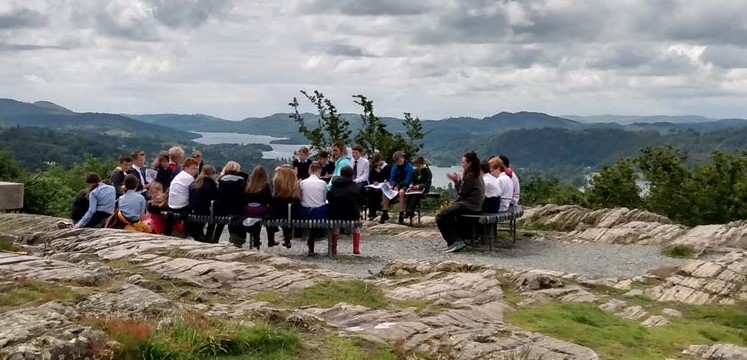
26 October 2022
Graham Watson is Cumbria’s John Muir Award Manager. He is hosted and supported in the role by the Lake District National Park Authority, supporting schools, outdoor centres and community groups to enjoy, learn about and care for the environment around them. Here he talks about what great outdoor learning looks like in two of Cumbria’s schools.
Outdoor learning takes many forms and can have many outcomes. At the John Muir Trust we have mapped how teachers link to subjects and themes across the curriculum when using the John Muir Award. The outdoors can make learning more exciting and relevant through using real world examples in both science and the arts.
To answer that, and ahead of Outdoor Classroom Day on 3 November, let’s look at some great outdoor learning I’ve seen recently, both from schools using the John Muir Award.
In June I walked to the top of Orrest Head, just above Windermere in the Lake District, slowly becoming aware of the sound of choral singing. It’s an accessible place, the ascent being a Lake District National Park Miles Without Stiles route, so can be popular, and has an inspirational view of the Lake District skyline. A class of 10 and 11 year olds were having an end of year celebration involving song and spoken word, and were clearly at home in and enjoying the setting. They’d walked from Windermere School, well known for its use of the outdoors to give pupils a broad experience of life. In this case, it was clear to me that the outdoors added inspiration, a sense of and connection with place, and confidence. Connection more than knowledge, we know from research, promotes pro-environmental behaviour, something that we need for meeting the climate and nature challenges of our world today.

Many schools in the Lake District make use of the outdoors, but also want to help nature thrive in their school grounds, often creating an ‘outdoor classroom’ in the process. Walney School have carved out time in their Year 7 curriculum and have 2 hours of outdoor learning every week. Inspired by visits to the nearby beach and Nature Reserves, they decided to create space for nature at school. Digging out a pond is a big task, but many hands make light work! To create more diversity and shelter they also worked with the Woodland Trust and planted 300 trees in the school grounds.


I’m really looking forward to visiting in coming years, seeing the pond and trees develop and hearing about the wildlife they attract. Again, this outdoor activity shows inspiration taken from the local wild places, followed up by actively creating more wild space for nature. The school also wanted to improve student wellbeing by being active, taking notice, connecting with nature, learning and giving back outdoors – recognised as 5 Ways to Wellbeing with Nature.
So, there you have it - two great examples of using the Outdoor Classroom in Cumbria! Find out more about using the John Muir Award in education settings, including curricula in Wales, Scotland and England, on the John Muir Trust website.